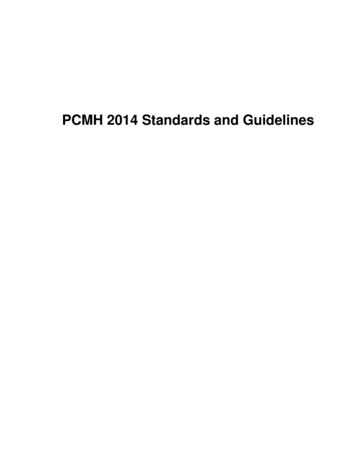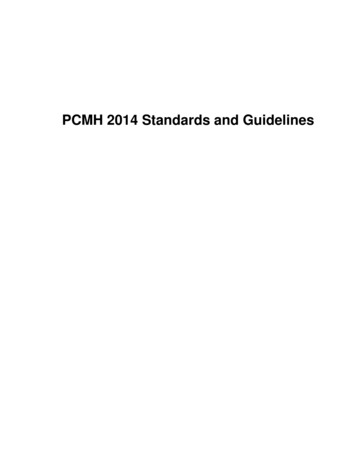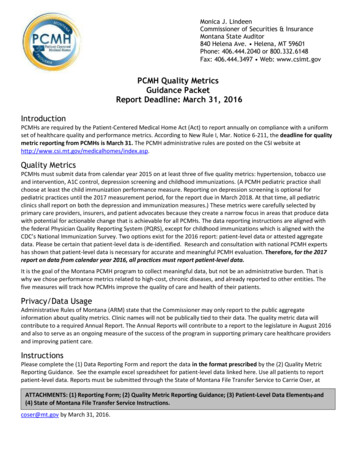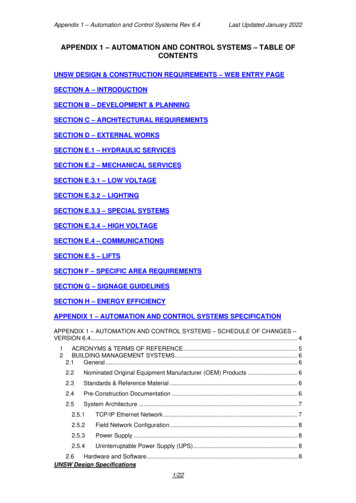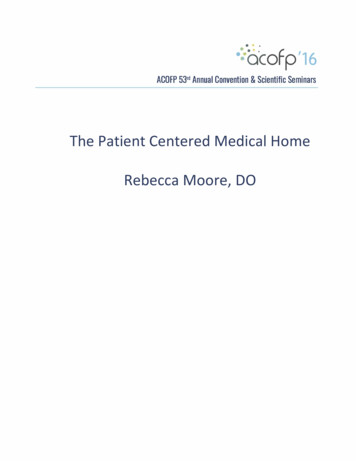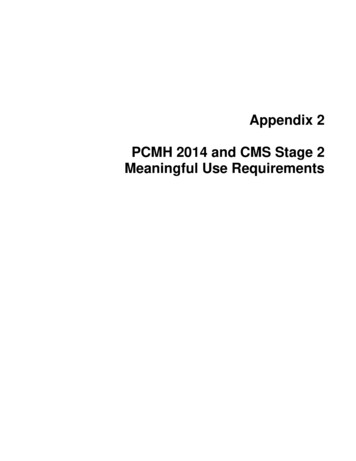
Transcription
Appendix 2PCMH 2014 and CMS Stage 2Meaningful Use Requirements
Appendix 2—PCMH 2014 and CMS Stage 2 Meaningful Use Requirements2-1APPENDIX 2PCMH 2014 AND CMS STAGE 2 MEANINGFUL USE REQUIREMENTSMedicare and Medicaid Electronic Health Record (EHR) Incentive Programs’ Meaningful Use RequirementsTo Qualify for Stage 2, All Eligible Providers Must Meet: The core set of 17 objectives. Three of 6 menu objectives. Report clinical quality measures.The PCMH 2014 standards align with the Medicare and Medicaid EHR Incentive Program Stage 2 Meaningful Use objectives. The release of the updatedPCMH standards in March 2014 coincides with the start of Stage 2 of Meaningful Use for most eligible professionals. By complying with the EHR incentiveprogram requirements, providers can obtain incentive payments and avoid downward payment adjustments.For more information about CMS Stage 2, go to lation/EHRIncentivePrograms/Downloads/Stage2 Guide EPs 9 23 13.pdfPCMH 2014 Standards, Elements and Factors2 Core Requirement Stage 2 Menu Requirement StagePCMH 1: Patient-Centered AccessElement A: PatientThe practice has a written process and defined standards for providing access toCentered Appointmentappointments, and regularly assesses its performance on:Access1. Providing same-day appointments for routine and urgent care.2. Providing routine and urgent-care appointments outside regular business hours.3. Providing alternative types of clinical encounters.4. Availability of appointments.5. Monitoring no show rates.6. Acting on identified opportunities to improve access.1StageMeaningful Use Stage 2 Requirements(Core and Menu Objectives)1NA2 Reference Grid: gfulusetablesseries2 110112.pdfJuly 28, 2014NCQA Patient-Centered Medical Home 2014
2-2Appendix 2—PCMH 2014 and CMS Stage 2 Meaningful Use RequirementsPCMH 2014 Standards, Elements and Factors2 Core Requirement Stage 2 Menu RequirementMeaningful Use Stage 2 Requirements(Core and Menu Objectives)1 StagePCMH 1: Patient-Centered AccessElement B: 24/7The practice has a written process and defined standards for providingAccess to Clinicalaccess to clinical advice and continuity of medical record informationAdviceat all times, and regularly assesses its performance on:1. Providing continuity of medical record information for care andadvice when the office is closed.2. Providing timely clinical advice by telephone.3. Providing timely clinical advice using a secure, interactive electronicsystem.4. Documenting clinical advice in patient records.Element C:The following information and services are provided to patients/Electronic Accessfamilies/caregivers, as specified, through a secure electronic system.1. More than 50 percent of patients have online access to theirhealth information within four business days of when theinformation is available to the practice .2. More than 5 percent of patients view, and are provided thecapability to download, their health information or transmittheir health information to a third party .3. Clinical summaries are provided within 1 business day(s) formore than 50 percent of office visits .4. A secure message was sent to more than 5 percent ofpatients .5. Patients have two-way communication with the practice.6. Patients can request appointments, prescription refills, referrals andtest results.NACORE REQUIREMENTS7. Provide patients the ability to view online, download andtransmit their health information within four business daysof the information being available to the EP.(1). More than 50 percent of all unique patients seen by the EPduring the EHR reporting period are provided timely (available to thepatient within 4 business days after the information is available to theEP) online access to their health information subject to the EP’sdiscretion to withhold certain information.(2). More than 5 percent of all unique patients seen by the EP duringthe EHR reporting period (or their authorized representatives) view,download, or transmit to a third party their health information.Exclusion 1: Any EP who neither orders nor creates any of theinformation listed for inclusion as part of both measures, except for“Patient name” and “Provider’s name and office contact information,may exclude both measures.Exclusion 2: Any EP who conducts 50 percent or more of his or herpatient encounters in a county that does not have 50 percent or moreof its housing units with 3Mbps broadband availability according tothe latest information available from the FCC on the first day of theEHR reporting period may exclude only the second measure.1Stage2 Reference Grid: gfulusetablesseries2 110112.pdfNCQA Patient-Centered Medical Home 2014July 28, 2014
Appendix 2—PCMH 2014 and CMS Stage 2 Meaningful Use RequirementsPCMH 2014 Standards, Elements and Factors2 Core Requirement Stage 2 Menu Requirement2-3Meaningful Use Stage 2 Requirements(Core and Menu Objectives)1 StagePCMH 1: Patient-Centered Access8. Provide clinical summaries for patients for each office visit.Clinical summaries provided to patients or patient-authorizedrepresentatives within 1 business day for more than 50 percent ofoffice visits.Exclusion: Any EP who has no office visits during the EHR reportingperiod.17. Use secure electronic messaging to communicate withpatients on relevant health information.A secure message was sent using the electronic messaging functionof CEHRT by more than 5 percent of unique patients (or theirauthorized representatives) seen by the EP during the EHR reportingperiod.Exclusion: Any EP who has no office visits during the EHR reportingperiod, or any EP who conducts 50 percent or more of his or herpatient encounters in a county that does not have 50 percent or moreof its housing units with 3Mbps broadband availability according tothe latest information available from the FCC on the first day of theEHR reporting period.PCMH 2: Team-Based CareElement A:The practice provides continuity of care for patients/families by:Continuity1. Assisting patients/families to select a personal clinician anddocumenting the selection in practice records.2. Monitoring the percentage of patient visits with selected clinician orteam.3. Having a process to orient new patients to the practice.4. Collaborating with the patient/family to develop/implement a writtencare plan for transitioning from pediatric care to adult care.NA1Stage2 Reference Grid: gfulusetablesseries2 110112.pdfJuly 28, 2014NCQA Patient-Centered Medical Home 2014
2-4Appendix 2—PCMH 2014 and CMS Stage 2 Meaningful Use RequirementsPCMH 2014 Standards, Elements and Factors2 Core Requirement Stage 2 Menu Requirement StagePCMH 2: Team-Based CareElement B: Medical Home The practice has a process for informing patients/families about the role of the medical homeResponsibilitiesand gives patients/families materials that contain the following information:1. The practice is responsible for coordinating patient care across multiple settings.2. Instructions for obtaining care and clinical advice during office hours and when the office isclosed.3. The practice functions most effectively as a medical home if patients provide a completemedical history and information about care obtained outside the practice.4. The care team provides access to evidence-based care, patient/family education and selfmanagement support.5. The scope of services available within the practice including how behavioral health needsare addressed.6. The practice provides equal access to all of their patients regardless of source ofpayment.7. The practice gives uninsured patients information about obtaining coverage.8. Instructions on transferring records to the practice, including a point of contact at thepractice.Element C: Culturally and The practice engages in activities to understand and meet the cultural and linguistic needs ofLinguistically Appropriate its patients/families by:Services1. Assessing the diversity of its population.2. Assessing the language needs of its population.3. Providing interpretation or bilingual services to meet the language needs of its population.4. Providing printed materials in the languages of its population.Element D: The PracticeThe practice uses a team to provide a range of patient care services by:Team1. Defining roles for clinical and nonclinical team members.2. Identifying practice organizational structure and staff leading and sustaining team basedcare.3. Having regular patient care team meetings or a structured communication processfocused on individual patient care.4. Using standing orders for services.5. Training and assigning members of the care team to coordinate care for individualpatients.6. Training and assigning members of the care team to support patients/families/caregiversin self-management, self-efficacy and behavior change.Meaningful Use Stage 2 Requirements(Core and Menu Objectives)1NANANA1Stage2 Reference Grid: gfulusetablesseries2 110112.pdfNCQA Patient-Centered Medical Home 2014July 28, 2014
Appendix 2—PCMH 2014 and CMS Stage 2 Meaningful Use RequirementsPCMH 2014 Standards, Elements and Factors2 Core Requirement Stage 2 Menu Requirement StagePCMH 2: Team-Based CareElement D: The Practice7. Training and assigning members of the care team to manage theTeam continuedpatient population.8. Holding regular team meetings addressing practice functioning.9. Involving care team staff in the practice’s performance evaluationand quality improvement activities.10. Involving patients/families/caregivers in quality improvementactivities or on the practice’s advisory council.PCMH 3: Population Health ManagementElement A: PatientThe practice uses an electronic system to records patient information,Informationincluding capturing information for factors 1–13 as structured(searchable) data for more than 80 percent of its patients:1. Date of birth. 2. Sex. 3. Race. 4. Ethnicity. 5. Preferred language. 6. Telephone numbers.7. E-mail address.8. Occupation (NA for pediatric practices).9. Dates of previous clinical visits.10. Legal guardian/health care proxy.11. Primary caregiver.12. Presence of advance directives (NA for pediatric practices).13. Health insurance information.14. Name and contact information of other health care professionalsinvolved in patient’s care.2-5Meaningful Use Stage 2 Requirements(Core and Menu Objectives)1CORE REQUIREMENTS3. Record the following demographics: Preferred language Sex Race Ethnicity Date of birth.More than 80 percent of all unique patients seen by the EPduring the EHR reporting period have demographics recordedas structured data.1Stage2 Reference Grid: gfulusetablesseries2 110112.pdfJuly 28, 2014NCQA Patient-Centered Medical Home 2014
2-6Appendix 2—PCMH 2014 and CMS Stage 2 Meaningful Use RequirementsPCMH 2014 Standards, Elements and Factors2 Core Requirement Stage 2 Menu RequirementPCMH 3: Population Health ManagementElement B: Clinical DataThe practice uses an electronic system with the functionality infactors 6 and 7 and records the information in factors 1–5 and8–11 as structured (searchable) data.1. An up-to-date problem list with current and activediagnoses for more than 80 percent of patients. 2. Allergies, including medication allergies and adversereactions* for more than 80 percent of patients. 3. Blood pressure, with the date of update for more than80 percent of patients 3 years and older. 4. Height/length for more than 80 percent of patients. 5. Weight for more than 80 percent of patients. 6. System calculates and displays BMI. 7. System plots and displays growth charts(length/height, weight and head circumference) andBMI percentile (0-20 years) (NA for adult practices). 8. Status of tobacco use for patients 13 years and olderfor more than 80 percent of patients. 9. List of prescription medications with date of updates formore than 80 percent of patients.10. More than 20 percent of patients have family historyrecorded as structured data. 11. At least one electronic progress note created, editedand signed by an eligible professional for more than30 percent of patients with at least one office visit. Meaningful Use Stage 2 Requirements(Core and Menu Objectives)1 Stage CMSMeaningful Use RequirementCORE REQUIREMENTS4. Record and chart changes in the following vital signs: Height/length Weight Blood pressure (ages 3 ) Calculate and display body mass index (BMI) Plot and display growth charts for patients 0-20 years,including BMI.More than 80 percent of all unique patients seen by the EP during theEHR reporting period have blood pressure (for patients age 3 ) andheight/length and weight (for all ages) recorded as structured data.Exclusion 1: Any EP who sees no patients 3 years or older is excludedfrom recording blood pressure.Exclusion 2: Any EP who believes that all 3 vital signs of height/length,weight, and blood pressure have no relevance to their scope of practiceis excluded from recording them.Exclusion 3: Any EP who believes that height/length and weight arerelevant to their scope of practice, but blood pressure is not, isexcluded from recording blood pressure.Exclusion 4: Any EP who believes that blood pressure is relevant totheir scope of practice, but height/length and weight are not, isexcluded from recording height/length and weight.5. Record smoking status for patients 13 years old or older.More than 80 percent of all unique patients 13 years old or older seenby the EP during the EHR reporting period have smoking statusrecorded as structured data.Exclusion: Any EP that neither sees nor admits any patients 13 yearsold or older.1Stage2 Reference Grid: gfulusetablesseries2 110112.pdfNCQA Patient-Centered Medical Home 2014July 28, 2014
Appendix 2—PCMH 2014 and CMS Stage 2 Meaningful Use RequirementsPCMH 2014 Standards, Elements and Factors2 Core Requirement Stage 2 Menu RequirementPCMH 3: Population Health ManagementElement B: Clinical Datacontinued2-7Meaningful Use Stage 2 Requirements(Core and Menu Objectives)1 StageMENU REQUIREMENTS2. Record electronic notes in patient records.Enter at least one electronic progress note created, editedand signed by an EP for more than 30 percent of uniquepatients with at least one office visit during the EHRreporting period. The text of the electronic note must be textsearchable and may contain drawings and other content.4. Record patient family health history as structured data.More than 20 percent of all unique patients seen by the EP duringthe EHR reporting period have a structured data entry for one ormore first-degree relatives.Exclusion: Any EP who has no office visits during the EHRreporting period. CMS REQUIREMENTElement C:Comprehensive HealthAssessmentTo understand the health risks and information needs of patients/families, the practice collects and regularly updates acomprehensive health assessment that includes:1. Age- and gender appropriate immunizations and screenings.2. Family/social/cultural characteristics.3. Communication needs.4. Medical history of patient and family.5. Advance care planning (NA for pediatric practices).6. Behaviors affecting health.7. Mental health/substance use history of patient and family.Although PCMH 3B Factors 1 and 2 are not listed as criteria,Stage 2, the Transitions of Care objective/measures require thatMedications, Medication Allergies, Problems are required to bepresent in the summary care record. So while no long an explicitobjective or measure on their own for Stage 2 these remain partof the requirements.NA1Stage2 Reference Grid: gfulusetablesseries2 110112.pdfJuly 28, 2014NCQA Patient-Centered Medical Home 2014
2-8Appendix 2—PCMH 2014 and CMS Stage 2 Meaningful Use RequirementsPCMH 2014 Standards, Elements and Factors2 Core Requirement Stage 2 Menu RequirementPCMH 3: Population Health ManagementElement C:8. Developmental screening using a standardized tool (NA forComprehensive Healthpractices with no pediatric patients).Assessment9. Depression screening for adults and adolescents using aContinuedstandardized tool.10. Assessment of health literacy.Element D: Use Data forAt least annually the practice proactively identifies populations ofPopulation Managementpatients and reminds them, or their families/caregivers, of needed carebased on patient information, clinical data, health assessments andevidence-based guidelines including:1. At least two different preventive care services. 2. At least two different immunizations. 3. At least three different chronic or acute care services. 4. Patients not recently seen by the practice5. Medication monitoring or alert.Element E: ImplementThe practice implements clinical decision support (e.g. point-ofEvidence-Based Decision care reminders) following evidence-based guidelines for:Support1. A mental health or substance use disorder.2. A chronic medical condition.3. An acute condition.4. A condition related to unhealthy behaviors.5. Well child or adult care.6. Overuse/appropriateness issues. StageMeaningful Use Stage 2 Requirements(Core and Menu Objectives)1CORE REQUIREMENTS11. Generate lists of patients by specific conditions touse for quality improvement, reduction of disparities,research, or outreach.Generate at least one report listing patients of the EP with aspecific condition.CORE REQUIREMENTS6. Use clinical decision support to improve performanceon high-priority health conditions.(1) Implement five clinical decision support interventionsrelated to four or more clinical quality measures at a relevantpoint in patient care for the entire EHR reporting period.Absent four clinical quality measures related to an EP’s scopeof practice or patient population, the clinical decision supportinterventions must be related to high-priority health conditions.(2). The EP has enabled and implemented the functionality fordrug-drug and drug-allergy interaction checks for the entireEHR reporting period.Exclusion: For the second measure, any EP who writes fewerthan 100 medication orders during the EHR reporting period.1Stage2 Reference Grid: gfulusetablesseries2 110112.pdfNCQA Patient-Centered Medical Home 2014July 28, 2014
Appendix 2—PCMH 2014 and CMS Stage 2 Meaningful Use RequirementsPCMH 2014 Standards, Elements and Factors2 Core Requirement Stage 2 Menu RequirementMeaningful Use Stage 2 Requirements(Core and Menu Objectives)1 StagePCMH 4: Care Management and SupportElement A: IdentifyThe practice establishes a systematic process and criteria for identifyingPatients for Carepatients who may benefit from care management. The process includesManagementconsideration of the following:1. Behavioral health conditions.2. High cost/high utilization.3. Poorly controlled or complex conditions.4. Social determinants of health.5. Referrals by outside organizations (e.g., insurers, health system, ACO),practice staff or patient/family/caregiver.6. The practice monitors the percentage of the total patient population identifiedthrough its process and criteria.Element B: Care Planning The care team and patient/family/caregiver collaborate (at relevant visits) toand Self-Care Supportdevelop and update an individual care plan that includes the following featuresfor at least 75 percent of the patients identified in Element A:1. Incorporates patient preferences and functional/lifestyle goals.2. Identifies treatment goals.3. Assesses and addresses potential barriers to meeting goals.4. Includes a self-management plan.5. Is provided in writing to the patient/family/caregiver.Element C: MedicationThe practice has a process for managing medications, and systematicallyManagementimplements the process in the following ways:1. Reviews and reconciles medications for more than 50 percent ofpatients received from care transitions. 2. Reviews and reconciles medications with patients/families for more than 80percent of care transitions.3. Provides information about new prescriptions to more than 80 percent ofpatients/families/caregivers.4. Assesses understanding of medications for more than 50 percent ofpatients/families/caregivers, and dates the assessment.5. Assesses patient response to medications and barriers to adherence formore than 50 percent of patients, and dates of assessment.6. Documents over-the-counter medications, herbal therapies and supplementsfor more than 50 percent of patients, and dates updates.2-9NANACORE REQUIREMENTS14. The EP who receives a patient from anothersetting of care or provider of care or believesan encounter is relevant should performmedication reconciliation.The EP who performs medication reconciliation formore than 50 percent of transitions of care in whichthe patient is transitioned into the care of the EP.Exclusion: Any EP who was not the recipient of anytransitions of care during the EHR reporting period.1Stage2 Reference Grid: gfulusetablesseries2 110112.pdfJuly 28, 2014NCQA Patient-Centered Medical Home 2014
2-10Appendix 2—PCMH 2014 and CMS Stage 2 Meaningful Use RequirementsPCMH 2014 Standards, Elements and Factors Stage 2 Core Requirement Stage 2 MenuRequirementPCMH 4: Care Management and SupportElement D: Use Electronic The practice uses an electronic prescription systemPrescribingwith the following capabilities.1. More than 50 percent of eligible prescriptionswritten by the practice are compared to drugformularies and electronically sent topharmacies. 2. Enters electronic medication orders in themedical record for more than 60 percent ofmedications. 3. Performs patient-specific checks for drug-drugand drug-allergy interactions. 4. Alerts prescriber to generic alternatives.Meaningful Use Stage 2 Requirements(Core and Menu Objectives)1CORE REQUIREMENTS1. Use computerized provider order entry (CPOE) for medication,laboratory and radiology orders directly entered by any licensedhealthcare professional who can enter orders into the medical recordper state, local and professional guidelines.More than 60 percent of medication, 30 percent of laboratory, and 30 percentof radiology orders created by the EP during the EHR reporting period arerecorded using CPOE.Exclusion: Any EP who writes fewer than 100 medication, radiology, orlaboratory orders during the EHR reporting period.2. Generate and transmit permissible prescriptions electronically (eRx).More than 50 percent of all permissible prescriptions, or all prescriptions,written by the EP are queried for a drug formulary and transmittedelectronically using CEHRT.Exclusion 1: Any EP who writes fewer than 100 permissible prescriptionsduring the EHR reporting period.Exclusion 2: Any EP who does not have a pharmacy within their organizationand there are no pharmacies that accept electronic prescriptions within 10miles of the EP’s practice location at the start of his/her EHR reporting period.6. Use clinical decision support to improve performance on high-priorityhealth conditions.(1) Implement five clinical decision support interventions related to four ormore clinical quality measures at a relevant point in patient care for the entireEHR reporting period. Absent four clinical quality measures related to an EP’sscope of practice or patient population, the clinical decision supportinterventions must be related to high-priority health conditions.(2). The EP has enabled and implemented the functionality for drug-drug anddrug-allergy interaction checks for the entire EHR reporting period.Exclusion: For the second measure, any EP who writes fewer than 100medication orders during the EHR reporting period.1Stage2 Reference Grid: gfulusetablesseries2 110112.pdfNCQA Patient-Centered Medical Home 2014July 28, 2014
Appendix 2—PCMH 2014 and CMS Stage 2 Meaningful Use RequirementsPCMH 2014 Standards, Elements and Factors2 Core Requirement Stage 2 Menu RequirementPCMH 4: Care Management and SupportElement E: Support SelfThe practice has, and demonstrates use of, materials to supportCare and Shared Decision patients and families/caregivers in self-management and sharedMakingdecision making. The practice:1. Uses an EHR to identify patient-specific education resourcesand provide them to more than 10 percent of patients 2. Provides educational materials and resources to patients.3. Provides self-management tools to record self-care results.4. Adopts shared decision making aids.5. Offers or refers patients to structured health education programssuch as group classes and peer support.6. Maintains a current resource list on five topics or key communityservice areas of importance to the patient population including servicesoffered outside the practice and its affiliates.7. Assesses usefulness of identified community resources.PCMH 5: Care Coordination and Care TransitionsElement A: Test TrackingThe practice has a documented process for and demonstrates that it:and Follow-Up1. Tracks lab tests until results are available, flagging and following upon overdue results.2. Tracks imaging tests until results are available, flagging andfollowing up on overdue results.3. Flags abnormal lab results, bringing them to the attention of theclinician.4. Flags abnormal imaging results, bringing them to the attention ofthe clinician.5. Notifies patients/families of normal and abnormal lab and imagingtest results.6. Follows up with the inpatient facility about newborn hearing andnewborn blood-spot screening (NA for adults).7. More than 30 percent of laboratory orders are electronicallyrecorded in the patient record. 8. More than 30 percent of radiology orders are electronicallyrecorded in the patient record. Stage2-11Meaningful Use Stage 2 Requirements(Core and Menu Objectives)1CORE REQUIREMENTS13. Use clinically relevant information from CEHRT toidentify patient-specific education resources andprovide those resources to the patient.Patient-specific education resources identified by CEHRT areprovided to patients for more than 10% of all unique patientswith office visits seen by the EP during the EHR reportingperiod.Exclusion: Any EP who has no office visits during the EHRreporting period.CORE REQUIREMENTS1. Use computerized provider order entry (CPOE) formedication, laboratory and radiology orders directlyentered by any licensed healthcare professional whocan enter orders into the medical record per state,local and professional guidelines.More than 60 percent of medication, 30 percent of laboratory,and 30 percent of radiology orders created by the EP duringthe EHR reporting period are recorded using CPOE.Exclusion: Any EP who writes fewer than 100 medication,radiology, or laboratory orders during the EHR reportingperiod.10. Incorporate clinical lab-test results into Certified EHRTechnology as structured data.More than 55 percent of all clinical lab tests results ordered bythe EP during the EHR reporting period whose results areeither in a positive/negative or numerical format areincorporated in CEHRT as structured data.1Stage2 Reference Grid: gfulusetablesseries2 110112.pdfJuly 28, 2014NCQA Patient-Centered Medical Home 2014
2-12Appendix 2—PCMH 2014 and CMS Stage 2 Meaningful Use RequirementsPCMH 2014 Standards, Elements and Factors2 Core Requirement Stage 2 Menu RequirementPCMH 5: Care Coordination and Care TransitionsElement A: Test Tracking9. Electronically incorporates more than 55 percent of all clinicaland Follow-Up continuedlab test results into structured fields in medical record. 10. More than 10 percent of scans and tests that result in an imageare accessible electronically. StageMeaningful Use Stage 2 Requirements(Core and Menu Objectives)1Exclusion: Any EP who orders no lab tests where results areeither in a positive/negative affirmation or numeric formatduring the EHR reporting period.MENU REQUIREMENTS3. Imaging results consisting of the image itself and anyexplanation or other accompanying information areaccessible through CEHRT.More than 10 percent of all tests whose result is one or moreimages ordered by the EP during the EHR reporting period areaccessible through CEHRT.Element B: ReferralTracking and Follow-UpThe practice:1. Considers available performance information onconsultants/specialists when making referral recommendations.2. Maintains formal and informal agreements with a subset ofspecialists based on established criteria.3. Maintains agreements with behavioral healthcare providers.4. Integrates behavioral healthcare providers within the practice site.5. Gives the consultant or specialist the clinical question, the requiredtiming and the type of referral.6. Gives the consultant or specialist pertinent demographic and clinicaldata, including test results and the current care plan.7. Has the capacity for electronic exchange of key clinicalinformation and provides an electronic summary of care recordto another provider for more than 50 percent of referrals. 8. Tracks referrals until the consultant or specialist’s report is available,flagging and following up on overdue reports.Exclusion: Any EP who orders less than 100 tests whoseresult is an image during the EHR reporting period; or any EPwho has no access to electronic imaging results at the start ofthe EHR reporting period.CORE REQUIREMENTS15. The EP who transitions their patient to anothersetting of care or provider of care or refers theirpatient to another provider of care provides asummary care record for each transition of care orreferral.EPs must satisfy both of the following measures in order tomeet the objective:(1) The EP who transitions or refers their patient to anothersetting of care or provider of care provides a summary of
Appendix 2—PCMH 2014 and CMS Stage 2 Meaningful Use Requirements 2-5 July 28, 2014 NCQA Patient-Centered Medical Home 2014 PCMH 2014 Standards, Elements and Factors Stage 2 Core Requirement Stage 2 Menu Requirement Meaningful Use Stage 2 Requirements (Core and Menu Objectives)1 PCMH 2: Team-Based Care Element D: The Practice Team continued 7.
